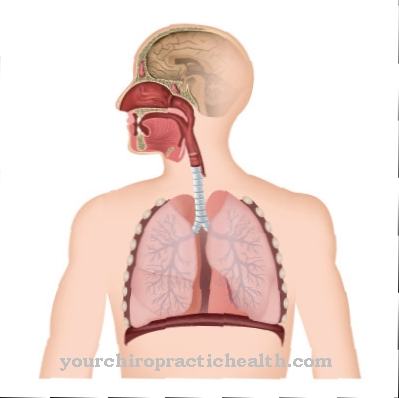Fabry disease (Fabry syndrome) is a rare hereditary metabolic disease with a progressive course, which can be traced back to a disturbance in the breakdown of fat in the body cells as a result of an enzyme deficiency. Male sufferers show a more pronounced course than female ones. Enzyme replacement therapy can slow down the course of Fabry disease and limit secondary diseases.
What is Fabry Disease?
.jpg)
© designua - stock.adobe.com
As Fabry disease or Fabry syndrome is a rare genetic metabolic disease associated with a disruption of enzyme activity.
In Fabry's disease there is an organism-wide deficiency of the enzyme alpha-galactosidase as a result of reduced or absent synthesis of the enzyme. Alpha-galactosidase regulates the breakdown of certain lipid metabolic substances in the lysosomes (cell organelles responsible for the breakdown of foreign substances).
As a result of the present disruption of this fat breakdown, glycosphingolipids, primarily ceramide trihexoside, are deposited in the cells, which leads to the cell damage characteristic of Fabry's disease and even death.
causes
Fabry disease is a genetic deficiency of the enzyme alpha-galactosidase, which leads to a disruption of fat breakdown in the lysosomes of the cells (lysosomal storage disease). In Fabry's disease, there is a genetic defect on the X chromosome (X-linked inherited disease), which leads to an impaired synthesis of the enzyme.
In Fabry's disease, this manifests itself either in a complete absence or a reduced concentration of alpha-galactosidase in the organism or in the synthesis of an inactive or only weakly active form of the enzyme.
The resulting accumulation of glycosphingolipids, in particular the non-degradable ceramide trihexoside, in the endothelial (inner-walled cells of the lymph and blood vessels) and smooth muscle cells of the blood vessels as well as in the nerve cells of the central and peripheral nervous system causes symptoms that are significant for Fabry's disease.
Symptoms, ailments & signs
It is characteristic of Fabry's disease that men are affected much more severely and more often than women. In women, the disease usually begins later with an overall milder course of the disease. The first symptoms appear in the first decade of life. This leads to sudden attacks of pain in the feet and hands.
The pain subsides within a few days. Furthermore, the patients suffer from tingling and burning in the hands and feet, which can be intensified by temperature fluctuations. In addition, nausea, vomiting and diarrhea are often observed in the children. This can lead to malnutrition due to chronic loss of appetite. The perspiration is often reduced.
This can lead to heat shock during physical exertion. Some patients also sweat more. Angiokeratomas develop on the buttocks, groin, thighs or navel. These are benign red-purple raised areas of the skin that are caused by local dilation of blood vessels.
Corneal opacity can also appear very early. In later stages, the kidneys, heart and brain are increasingly affected. Without treatment, these organ involvements inevitably lead to death in the course of the disease. Renal insufficiency usually begins in the second or third decade of life and was previously considered the most common cause of death in Fabry disease.
Furthermore, heart diseases such as angina pectoris, cardiac arrhythmias or heart valve defects often occur. Strokes often occur before the age of 50, which are caused by changes in blood vessels in the brain.
Diagnosis & course
At Fabry disease an initial suspicion is based on characteristic symptoms such as eye changes (corneal changes, lens opacities), bluish-red to blackish changes in the skin and mucous membranes (so-called angiokeratomas), paresthesias (tingling and / or numb, burning sensation in the hands or feet), disorders of the body's heat regulation ( decreased or increased sweating) as well as hearing loss and proteinuria (protein in the urine).
The diagnosis of Fabry disease is confirmed by determining the alpha-galactosidase activity and ceramide trihexoside concentration in the blood. A lack of or reduced activity of the enzyme and an increased concentration of ceramide trihexoside indicate Fabry's disease. In addition, the diagnosis can be confirmed using a kidney biopsy and a genetic test.
Fabry's disease usually has a progressive, lethal (fatal) course and, if left untreated, leads to damage to the kidneys (renal insufficiency), heart (heart valve insufficiency) and brain (ischemic insults). However, the symptoms and complications of Fabry disease can be limited by starting therapy early.
Complications
With Fabry disease, those affected suffer from severe pain. These can also occur in the form of resting pain and lead to sleep disorders or other complaints, especially at night. Sensitivity disorders or paralysis in different parts of the body can also occur and make everyday life more difficult for the patient.
Those affected also suffer from increased perspiration and various changes in the skin. These can also have a negative effect on the patient's aesthetics. If Fabry's disease is not treated, it can also lead to problems in the cardiovascular system, which in the worst case can lead to death of the person concerned. The patient's quality of life is significantly reduced by Fabry's disease.
Likewise, hearing loss or, in the worst case, complete deafness can develop. People can also have kidney failure and die from it. Fabry disease is treated with the help of infusions.As a rule, those affected are dependent on lifelong therapy, since a causal treatment of the disease is not possible. In some cases, a kidney transplant is also necessary. Patients must also follow a healthy lifestyle and usually avoid nicotine.
When should you go to the doctor?
Pain and pain attacks should be presented to a doctor. If they occur, there is a need for action as soon as possible. You should refrain from taking pain medication until you have consulted your doctor, as there is a high risk of possible complications. A doctor will be needed if vomiting, diarrhea, nausea, or general malaise occur. If there is loss of appetite or unwanted weight loss, a doctor should be visited to clarify the cause. Decreased sweat production is a sign of health impairment that should be investigated. If a feeling of internal dryness occurs during physical exertion, dehydration threatens in severe cases. The sick person suffers a potentially life-threatening condition that must be treated as quickly as possible.
A doctor is also needed if there are fluctuations in body temperature or sensory disturbances. A tingling sensation in the limbs or burning sensation should be presented to a doctor. Impairment of vision or clouding of the cornea are signs of a condition that needs investigated and treated. In the case of general functional disorders, irregularities in the heart rhythm and circulatory disorders, a visit to a doctor is advisable.
Reduced performance or persistent psychological problems should be discussed with a doctor so that the cause can be clarified. Since Fabry disease can lead to death if left untreated, a doctor should be consulted as soon as the first discrepancy occurs.
Treatment & Therapy
Fabry disease is usually treated causally as part of enzyme replacement therapy with genetically synthesized alpha-galactosidase. The infusion of synthetic alpha-galactosidase compensates for the enzyme deficiency and alleviates the symptoms by gradually breaking down the metabolic products stored in the cells, while at the same time preventing further accumulation.
Correspondingly, enzyme replacement therapy can significantly slow down the progression of the disease. Since the synthetic enzyme is also broken down within the body's own breakdown processes, regular (usually every two weeks) and lifelong infusions are required. While the first infusions should take place under medical supervision, they can also take place as part of home therapy in the further course of therapy and if the drug is well tolerated.
In addition, the symptoms and complaints present are treated in parallel (symptomatic therapy). For example, dialysis or a kidney transplant may be required at an advanced stage of Fabry disease, which is often associated with kidney failure. In addition, a low-fat diet, adequate fluid intake, avoidance of nicotine consumption and the avoidance of stress- and pain-causing factors are recommended for Fabry disease.
You can find your medication here
➔ Medicines for painOutlook & forecast
For the prognosis of all Fabry disease sufferers, it is crucial that the disease is recognized and treated early. If left untreated, the increasing accumulation of globotriaosylsphingosine (LysoGb3) leads to more and more damage to vital organs until they can no longer perform their function. For those affected who have not been treated, the average life expectancy is 50 years for men and 70 years for women.
Compared to the population as a whole, this equates to a reduction in life expectancy of 20 or 15 years. Those affected eventually die of terminal kidney failure or cardiovascular or cerebrovascular complications such as cerebral haemorrhage, cerebral infarction or heart attack. With adequate and early treatment, the prognosis is good.
In general, the later the diagnosis and the start of treatment, the more the life expectancy is reduced. If nephropathy (kidney disease) or advanced cardiomyopathy (heart muscle disease) has already developed, this has a negative impact on the prognosis. Repeated strokes and transient ischemic attacks (circulatory disorders in the brain) also worsen the prognosis. Renal, cerebrovacular and cardiovascular complications can also reduce life expectancy.
In individual cases, strokes and transient ischemic attacks can even occur as the first manifestation of Fabry's disease. According to a study, 50 percent of the male and 38 percent of the female affected suffered their first stroke before the initial diagnosis.
prevention
As it is with Fabry disease If it is a genetic metabolic disease, there are no preventive measures. An early diagnosis and an early start of therapy can, however, have a positive influence on the course of the disease and limit secondary diseases. For example, Fabry's disease can be diagnosed in children of an affected parent as part of a prenatal diagnosis as early as the 15th week of pregnancy, which ensures that therapy can be started earlier.
Aftercare
In the case of Fabry syndrome, follow-up measures are very limited in most cases. Since it is a hereditary disease, it usually cannot be completely cured. Those affected are therefore dependent on an early diagnosis so that there are no further complications or worsening of the symptoms.
If you want to have children again, genetic testing and counseling can be performed to prevent the syndrome from recurring. With Fabry syndrome, those affected are usually dependent on taking various medications. The doctor's instructions should be followed, but always contact the doctor first if you have any questions or are unclear.
Because the disease cannot be fully treated, some people need dialysis or, as the disease progresses, a kidney transplant. The support and care of one's own family has a very positive effect on the further course of the disease and can also prevent depression or other psychological upsets. In many cases, Fabry syndrome reduces the life expectancy of those affected.
You can do that yourself
The various symptoms in the area of digestion and the gastrointestinal tract can be counteracted with a suitable and balanced diet. It helps many patients to keep a food diary and thus to be able to classify the tolerance of different foods for themselves. Here, those affected note which foods they ate and when. At the same time, the following gastrointestinal complaints are written down so that possible intolerances can be analyzed.
There is no general dietary recommendation, as every patient suffers from various digestive problems and the choice of food should therefore be adapted to individual needs. Basically, experts advise Fabry's disease patients to eat as low in fat as possible. In the advanced stages of the disease, special diets may be necessary, as kidney function e.g. can be affected by a diet high in sodium (too much salt).
For many of those affected, contact with a self-help group is also helpful. Exchanging ideas with other patients is an important support especially for the psychological suffering that can go hand in hand with the illness. In addition, tips for dealing with Fabry's disease on a daily basis can be shared. Contact points and discussion groups can be found online.




.jpg)
.jpg)







.jpg)

.jpg)
.jpg)











.jpg)